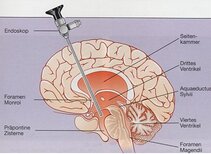Hydrocephalus
The hydrocephalus represents a pathologiacal medical condition with increase of cerebrospinal fluid, the so-called liquor, in an expanding ventricle system (brain cavities). The hydrocephalus is not a disease per se but the result of congenital and/or acquired factors which prevent the normal drainage of liquor. This causes an increased pressure inside the skull, also known as increased intracranial pressure. This may develop slowly or quickly.
In infants with hydrocephalus, the symptoms are an abnormally enlarged head circumference, a tense and bulged fontanelle, a conspicuous eye position, the so-called sundown phenomenon, as well as irritability, difficulties in drinking, developmental disorders, and a pre-bulged forehead. In older children, when the sutures are closed, the symptoms of increased intracranial pressure occur, such as headache, vomiting, often fasting, impaired conciousness, impaired vision, and epileptic seizures. Due to the increased pressure within the skull, the brain and optic nerves are damaged which may – without treatment - finally lead to blindness or even death.
In case of signs of increased intracranial pressure such as acute vomiting, headache, decrease of conciousness, and also abnormalities (changes) in personality/behaviour, the child should be admitted immediately to a medical center for pediatric neurology or pediatric neurosurgery!
In the following you will find information on the two forms of hydrocephalus, the obstructive (non-communicating) hydrocephalus and the non-obstructive (communicating) hydrocephalus.
Obstructive hydrocephalus
In case of an obstructive hydrocephalus, the cerebrospinal fluid cannot drain via its normal path, which means that some kind of blockade prevents this. The blockade can be caused, for example, by a mass lesion such as a tumour, cyst, or malformation. Or there is a stenosis of the aqueduct, which is the duct connecting the upper and lower brain cavities.
The treatment of the obstructive hydrocephalus aims, whenever possible, at removing the obstruction. That means, it is intended to remove the mass lesion, for example, a tumour, which causes the blockade. Should the mass lesion not be removable, the treatment must bypass the blockade. This can be achieved by a shunt. The shunt is a catheter system which drains the cerebrospinal fluid from the brain cavities into the peritoneal cavity or into the heart. An alternative treatment may be to the endoscopic/surgical creation a new opening with a tube which allows the liquor to bypass the blockade. This is the so-called ventriculostomy.
Non-obstructive hydrocephalus (hydrocephalus malresorptivus)
Non-obstructive hydrocephalus, also known as hydrocephalus malresorptivus is caused by impairment of the natural cerebrospinal fluid resorption areas. This impairment is often caused by a hemorrhage or an infection. In particular, the still immature brain of premature infants is endangered by hemorrhages of the brain. The treatment with a shunt is safe and effective. The cerebrospinal fluid drains through a silicon catheter into the peritoneal cavity or into the heart. The amount of liquor that has to be drained is regulated by a valve.
Different treatment modalities of the forms of hydrocephalus are offered in our clinic. For the treatment of these children close and regular monitoring is also necessary. A team of pediatric neurologeons and neurosurgeons controls the course of development of the child and the location of the shunt and the stomy, respectively.

Dr. Mukesch Shah, MD
Senior neurosurgeon
Children consultation hours

Dr. Florian Volz, MD
Attending neurosurgeon


